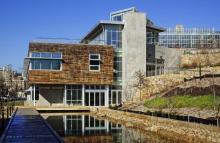Policy & Codes
Energy Codes and Zero Energy Buildings: Strategies for Today, Tomorrow, and Beyond
New building energy codes have arrived and others are on the horizon. This intensive session begins by introducing the newest codes in the region: specifically the amended IECC2015/ASHRAE 90.1-2013 and updated stretch code in Massachusetts as well as the stretch code and zero energy plan under development in Rhode Island and New York.
The "Anti-Greenwash" Guide to Community Electricity Aggregation
Can a community get more renewable electricity for all of its residents at a competitive price? Massachusetts communities have the option to choose an electricity supplier for their residents and businesses through “community choice aggregation” (CCA) in order to obtain better pricing and more renewable energy.
The AIA 2030 Commitment: Building Energy Literacy
The AIA 2030 Commitment has impacted not only how we design, but also how firms practice. It has changed the way firms work by integrating performance information into the design process. This session is relevant to both those interested in learning more about the Commitment as well as current signatories, and will cover new tools and developments, such as the online performance tracking tool, the Design Data Exchange.
Retrofitting Residential Properties
One-to-four unit homes present special challenges to energy-efficiency upgrades. Many of these homes were built from 1890—1960 and lack insulation, leak air, and waste energy and water. This panel will share data and solutions to improve the energy- and water- efficiency of these homes, discuss cost-benefit analyses of planned improvements, describe options for testing results of completed upgrades, and explore how to pay for this work.
Are You the Weakest Link? Resilient Design 101
Buildings are designed to be expendable. Codes focus on safe evacuation in an emergency, not on keeping buildings occupiable through a disaster. With climate change, displacement due to damage from extreme weather events like Superstorm Sandy is more common. Is building to code minimums really enough?
Using the Building Permitting Process to Accelerate Clean Energy
Traditional clean-energy and energy-efficiency incentive programs wait for people to apply. But what if building permitting, which funnels construction in every city and town, were connected to incentive programs? This session will present ideas to expand integration between incentives and permitting, to streamline the process, and to increase participation in energy-efficiency programs. Bring your ideas to enrich the dialogue.
HERS Raters: They Do Play Well With Others
HERS raters do more than “crank out a model and give you a number” – the right HERS rater can be a building science practitioner who helps project teams throughout design and development, filling a role analogous to structural engineer or code compliance consultant. If you don't have a HERS Rater on your team, your life is probably a lot more difficult than it needs to be.
NYSERDA - Transforming the clean energy landscape in commercial and multifamily buildings
Join NYSERDA to learn about its Clean Energy Fund initiatives for the multifamily and commercial building industry. This session will highlight current and upcoming programs to help overcome barriers to energy efficiency in commercial and multifamily buildings.
The Future of Net Zero Energy
Net Zero Energy Buildings have reaching a tipping point. The economic limitations that restricted their success in the past have changed drastically and the technologies needed to achieve Net Zero Energy are now readily available. This session will uncover the strategies and technologies used and the policies and programs in place that are accelerating the uptake of Net Zero Energy Buildings and Communities. This session will also highlight inspiring case studies including project teams’ motivation for pursuing Net Zero Energy Building Certification, how they achieved it and how they maintain performance over time. Brad Liljequist, Technical Director of the Net Zero Energy Program of the Living Building Challenge, will uncover the trends emerging in Net Zero Energy and discuss how each participant can take the lessons learned into their own practice.
Drivers, Trends, and Tools for Healthier Materials Selection
This session will educate participants on drivers, tools, and trends for healthier materials selection. As LEED v4 and the Living Building Challenge's Materials Petal become mainstream, designers are starting to focus on material's environmental and human health impacts. In the past, "green" materials were simply defined by physical attributes: the amount of recycled and regional content, allowable VOC's, etc. Because we are now tasked with demonstrating optimization across the entire supply chain, tools and practices which facilitate "transparency" and maximize designers' decision making capabilities are emerging. This presentation will introduce the following: Red Lists, Environmental Product Declarations (EPD's), Health Product Declarations (HPD's), and extended producer responsibility. Our panel experts include a manufacturer which is promoting these tools and finding many benefits through their supply chain optimization, as well as local practitioners who are developing the tools and guiding their implementation.

